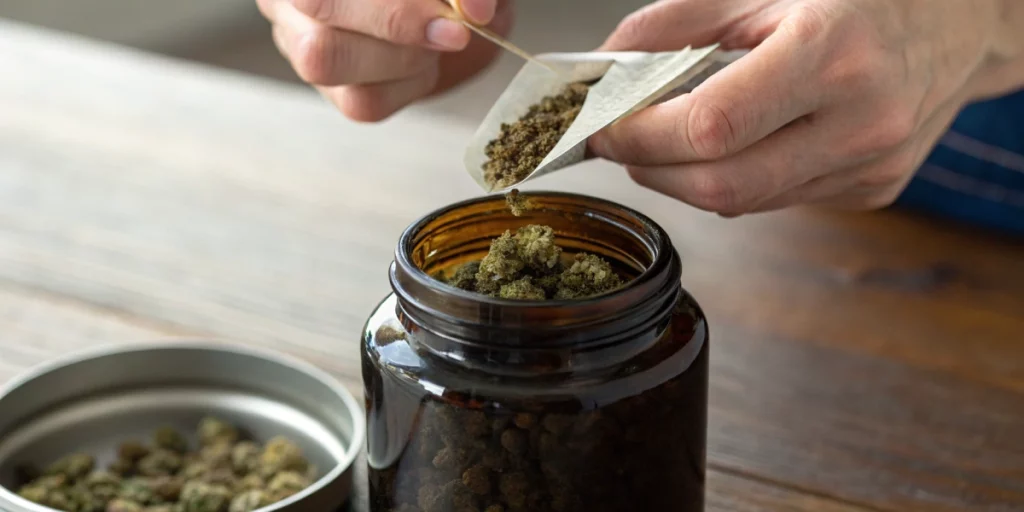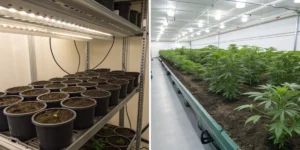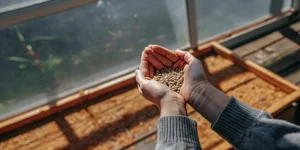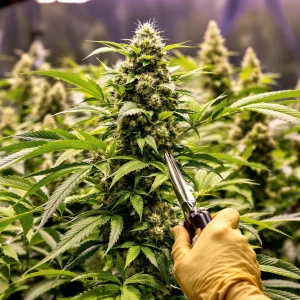Why Proper Storage Matters
Maintaining germination rates
Proper handling keeps seed embryos active and ready to sprout when you plant them. You store seeds under steady temperature and humidity so they don’t dry out or absorb too much moisture. By doing this, you maintain high sprouting percentages, which means more reliable harvests and less waste. Good storage lets every seed perform at its peak when you sow it, ensuring you get the outcomes you expect each growing cycle. Consistent conditions also minimize slow or uneven sprouting, so seedlings emerge uniformly, making care and nutrient distribution easier.
If you let conditions fluctuate, you risk damage deep inside the seed coat. Tiny cracks or microfractures can form, letting moisture in and harming the embryo. Over time, these flaws reduce germination rates and leave you with uneven or failed sprouts. By committing to proper seed care, you invest in every seed’s potential and avoid wasted time and resources chasing inconsistent results. This attention helps growers maintain predictable timelines and quality standards across every planting round.
Preventing mold and rot
Seed mold thrives in damp, warm settings, and once it takes hold it spreads quickly. You must keep relative humidity low and air fresh. Stagnant air and moisture create the perfect incubator for fungal colonies that ruin seeds in days. Storing in airtight, dry containers prevents mold spores from settling and keeps rot at bay so you can trust your seeds remain sound. Including oxygen absorbers adds another layer of protection against microbial growth.
Rot happens when water seeps past outer layers and reaches the living core. That attack kills the embryo and halts sprouting ability forever. Even one infected seed can seed mold spores into nearby batches. You guard against this threat by checking storage areas and replacing any damp packing material immediately. This vigilance saves entire seed collections from decay. Regular container inspections let you spot early signs of rot before larger losses occur.
Preserving genetics
Each seed carries unique genetic traits you’ve selected for taste, aroma or yield. When you misstore seeds, heat or humidity can trigger premature metabolism and degrade those special compounds. Proper seed care locks in those traits until planting, preserving the distinct profile you cultivated over multiple generations. That genetic fidelity builds consistency among batches and helps maintain grow quality.
Genetic integrity relies on stable conditions that halt aging processes within the seed. Heat accelerates enzyme activity and humidity encourages respiration, both of which drain stored nutrients. By stopping that activity with cool, dry storage, you freeze seeds in time. This way you maintain breeders’ work and ensure consistency in every crop. Proper labeling and organization further ensure each genetic line stays distinct.
Ideal Storage Conditions
Temperature guidelines
Cool storage slows down metabolic processes inside the seed and extends viability. Aim for consistent temperatures between 3 °C and 8 °C (37 °F–46 °F). A dedicated refrigerator set to the right range works well. Keep seeds away from freezer compartments and coils, which can cause unwanted cold shocks. Use small digital thermometers to verify exact conditions inside each container. This is especially important for premium genetics like the Haze Berry Auto Strain, where preserving seed quality ensures optimal germination.
Avoid rooms where heating or cooling vents blow directly on your containers. Seasonal shifts in ambient temperature can damage seeds if the difference between day and night exceeds 10 °C. Use a reliable thermometer in each storage area and monitor daily. Stability matters more than absolute values, since fluctuations can harm embryos. Insulated storage boxes also help cushion against rapid external changes.
Humidity control
Seeds that absorb moisture swell and activate biochemical pathways prematurely. You target relative humidity around 20 %–30 %. You achieve this by adding desiccant packs inside your storage containers. Replace those packs when they show saturation, usually every three to six months, depending on conditions. Calibrated hygrometers help track RH inside each jar.
Ambient humidity rarely stays within that window, so you seal seeds inside airtight jars or vacuum packs. That barrier prevents humid air from seeping in. If you open a container, let it sit closed again for at least 24 hours to re-establish dry conditions before resealing. Consistency here directly impacts long-term viability. You might also use humidity indicator cards for quick, visual checks.
Light protection
Ultraviolet and visible light can degrade chlorophyll-like compounds inside seeds, harming embryo structures. You shield seeds by using opaque or dark-colored containers. Store them in a drawer or box that blocks all incoming light. Even brief exposure during inspections adds up over months. Tight-fitting lids prevent stray light from reaching delicate seeds.
Avoid transparent plastic bags or clear glass jars unless you enclose those in a dark sleeve. Each time you expose seeds to light you trigger minor photochemical reactions. Those might not kill the seed instantly, but over time they chip away at vigor and performance. Total darkness keeps seeds fully viable. Consider labeling each container clearly to reduce unnecessary handling and exposure.
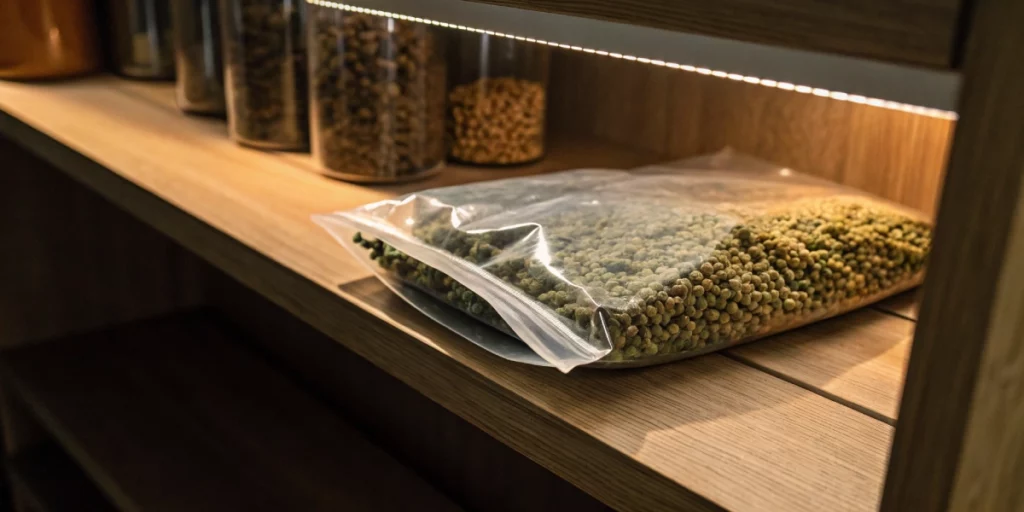
Best Storage Containers and Materials
Airtight glass jars
Glass jars with rubber gaskets offer an excellent barrier against moisture and air. They won’t off-gas chemicals that affect seed health. You simply layer a desiccant packet inside and lock the lid. That combination keeps humidity low and embryos safe. Glass doesn’t deform over time, maintaining a secure seal for years.
Glass also lets you peek at seed condition without opening the container. You check for condensation or mold spots through the jar wall. If you spot issues, you can replace desiccant packs or transfer seeds immediately. This transparency cuts down on unnecessary handling. For extra security, use jars fitted with vacuum valves — an ideal option when storing sensitive genetics like Hulkberry Auto Strain, which benefits from stable, controlled environments to maintain viability.
Vacuum-sealed bags
Vacuum sealing removes oxygen and reduces moisture exposure. You place seeds in a food-grade vacuum pouch and use a pump to extract air. This method adds an extra layer of protection, especially if you plan freezer storage. Vacuum packs also reduce bulk, making it easier to store multiple varieties.
Ensure you leave no sharp objects inside the bag to avoid punctures. After sealing, label each bag with the seed strain and date. That record-keeping saves you confusion later when you manage multiple varieties over time. Sturdy mylar or foil-lined bags perform best for long-term durability.
Desiccant packs
Silica gel or clay-based desiccants absorb excess moisture in closed containers. You tuck packets around seeds to maintain targeted humidity levels. Choose reusable packs that you can recharge by baking at low temperature and swap back in. Indicator beads show when they need reactivation.
Always check packets for color-change indicators if available. Those markers show when the desiccant has loaded and needs regeneration. Fresh desiccant ensures you never leave seeds unprotected against ambient moisture. While focusing on proper seed storage, some growers also explore topics like How to Smoke without Papers to expand their cannabis knowledge beyond cultivation. Store extra packs separately in an airtight box to keep them ready.
Long-Term vs. Short-Term Storage
Refrigerator vs. freezer
Refrigeration suits storage up to two years. It slows metabolism without risking ice crystal damage. Place containers in the main section, away from walls and vegetable drawers. Frequent door openings can cause temperature swings, so choose a low-traffic spot inside. Dedicated mini-fridges work well for serious growers.
Freezing extends viability beyond five years if you dry seeds appropriately and pack them airtight. However, moisture trapped inside can form ice and crack seed coats. Only freeze seeds once you guarantee below 5 % moisture content in both seed and packing material. Consider using vacuum-sealed glass vials inside foil bags for best results.
Shelf life expectations
Under ideal conditions, seeds remain viable for two to four years with minimal loss in germination. Refrigerated storage offers consistent performance, though you’ll see a slight annual drop of 2 %–5 %. You plan planting schedules around that decline to use older seeds first. Keep strain-specific logs to know exactly when each batch was stored.
In freezer storage, you might see viability decline under 1 % per year. Yet seeds still age in subtle ways you can’t reverse. Keep detailed logs of purchase date and storage start to track seed age. That practice prevents surprises when you need a fresh batch. Sorting seeds by date and strain ensures you always tap the oldest viable stock first.
Periodic viability checks
Testing seeds every year helps you gauge actual germination rates before committing to planting. You place ten seeds on damp paper towels in a warm spot and count sprouts over a week. This simple test informs you which batches need replacement soon. It also reveals if storage conditions slipped without your knowledge.
Record each test’s results alongside storage notes. If germination falls below 70 %, you retire that batch. Doing checks only requires minimal material and ensures you don’t waste grow space or nutrients on low-viability seeds. Regular testing keeps your grow plan on track and prevents disappointing yields.
Common Storage Mistakes to Avoid
Frequent temperature swings
Fluctuating temperatures stress seeds by forcing them in and out of dormancy. You avoid storing seeds near heating vents, windows or refrigerators that open often. Instead, select a dedicated appliance or insulated box with stable internal climate. Add thermal buffers like foam inserts to reduce rapid shifts.
Regular spikes or drops as small as 5 °C can harm embryo structure. You reduce this risk by using storage containers with thermal buffering, such as foam-lined boxes or insulated coolers. That extra layer cuts rapid heat exchange and protects seeds. Consistent monitoring through data loggers alerts you to unwanted changes.
Exposure to light
Leaving seeds in clear bags or jars on a shelf invites photodegradation over time. Pack seeds in opaque pouches or wrap glass containers in dark cloth. Even brief exposure adds up, so you minimize the number of times you open the packaging. Use low-intensity task lights when you inspect batches.
When examining seeds like Bruce Banner 3 Autoflower, work under dim conditions and complete your check quickly. The less light you let in, the better you preserve embryo health. Consistent darkness simulates underground conditions until you plant. Keep all lights off in the storage area and rely solely on natural checks during container opening.
High humidity
Storing seeds in damp basements or bathrooms almost guarantees mold and embryo decay. You pick storage areas with naturally low moisture, such as a climate-controlled pantry or dedicated seed fridge. Outside that, use dehumidifiers to remove excess humidity. Combine with sealed containers for best results.
Never rely solely on container seals in humid locations. Always pair with fresh desiccant packs and monitor with a wireless hygrometer if possible. That dual-approach keeps humidity in check and seeds safe. During humid seasons, inspect packs monthly and swap desiccants promptly to avoid any moisture surprise.
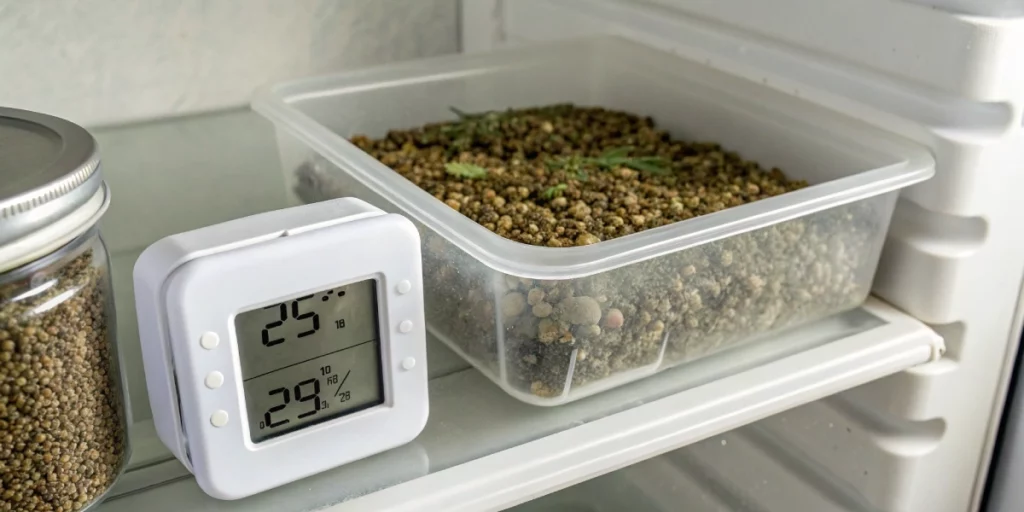
FAQs about cannabis seed storage
How long can seeds last in the fridge?
Seeds stored at steady fridge temperatures can remain viable for up to two years with minimal loss. You’ll likely see a germination drop of around 5 % each year, so older seeds still perform well but in slightly lower numbers. Check them annually to avoid surprises.
Can I store seeds in the freezer?
Yes, if seeds reach below 5 % moisture before freezing, you can extend viability beyond five years. Make sure you use airtight, vacuum-sealed bags and double-check that no condensation forms when you remove seeds. Use insulated packaging to cushion against temperature shocks.
What’s the function of silica gel packs?
Silica gel packets absorb residual moisture inside storage containers to keep relative humidity low. By placing them alongside seeds, you prevent mold growth and maintain the dry conditions seeds need for long-term health. Recharge packs regularly to keep them effective.

